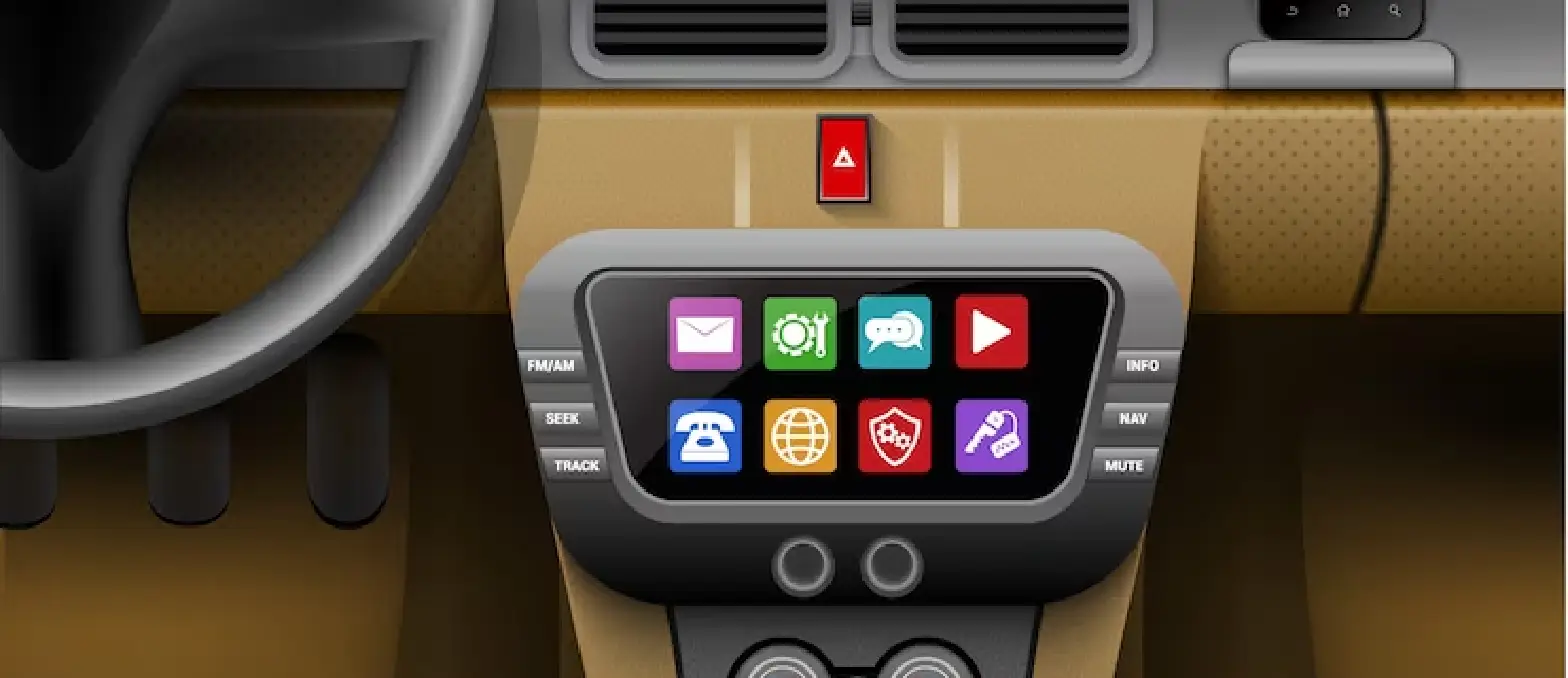Table of Contents
Imagine this, when you sit in your car for a ride, the in-built cameras track the identity of your passengers, seats adjust automatically for better comfort, and infotainment system switches to audio or video of your choice, syncs with a mobile device you use and start the download of TV shows through your portable devices.
Your car searches the nearest gas or fuel station when a battery or gasoline dies. In-car equipment controls your mobile apps for picking-up or rejecting calls. Also, when on road, navigation provides real-time traffic updates and checks vehicle conditions to turn down any safety risk. All of this is getting possible via modern in-vehicle infotainment systems today.
Many automotive companies are looking to build smart in-vehicle information systems to deliver a better customer experience. But, before you partner with a reliable custom software development company to get a custom solution, knowing what car infotainment system is all about is important.
What is an In-Vehicle Infotainment (IVI) System?
An in-vehicle infotainment system refers to a suite of applications or software that deliver entertainment and information together to the car rider and passengers during a ride. It uses a variety of vehicle control elements like touch screen display, speakers, button panels and other features for the same.
Some of the most popular IVI services include navigation, news, music, entertainment, healthcare and much more. This results in a fully connected car experience for consumers.
How Does it Work?
From a user’s perspective, IVI systems should be easy to use and navigate with plug and play capacities. And that’s what software developers are aiming for right now. Of course, IVI systems are not just about connecting a smart device and managing multimedia. They are more sophisticated than that.
Car infotainment systems work with a combination of in-vehicle and external systems to deliver information and entertainment in a synchronous fashion to the car riders.
The key components of the IVI system that interact with these systems are:
- Integrated Head Unit
- Heads-Up Display
- High-end DSPs and GPU
- IVI System OS
- Connectivity Modules
- Automotive Sensors
- Digital Instrument Cluster
Experience the power of bespoke software
IVI Software: Market Trends & Statistics
The global in-vehicle infotainment market is expected to be worth $42.7 billion by 2025 at 10.3 per cent CAGR. The rising demand for automotive solutions that promote in-car comfort and entertainment is the primary reason for such rapid growth. The other reasons include an increase in car production, technology advancements and new telematics regulations.
Modern In-vehicle infotainment systems offer music, entertainment, mobile integration and FM support – which makes them an ideal entertainment option for most car buyers today.
In the coming years, automotive infotainment systems will serve the dual role of the vehicle control center as well as an entertainment system. The incorporation of AR/VR will further enhance the driving experience and comfort for customers. Development in this direction has also already begun in many countries.
Popular Car Infotainment System Development Services
As we discussed, the demand for high-performing and feature-rich car infotainment systems is growing rapidly. So, a majority of automotive software product engineering companies now provide end-to-end, in-vehicle infotainment (IVI) system development services. Popular services include:
- IVI HMI & Application Development
- IVI Development & Integration
- IVI Platform Design & Maintenance
- IVI Maintenance and Support
- IVI System Security
Benefits of Automotive In-vehicle Infotainment System
- Smarter Navigation Option
- Multimedia Streaming
- Hands-Free Calling
- Mobile App Support
- High Security
- Superior Vehicle Control

Features of In-vehicle Infotainment System
Some of the most common features and technologies of modern car infotainment systems are given below:
High-Resolution Touch Screen
A modern in-vehicle infotainment system should use high-quality LCD, TFT and AMLCD (Full-color active matrix LCD) panels. The software inside must also run on these displays without any lag or delay. The display should range between 2 to 12 inches depending upon the car type.
Mobile Pairing
Mobile apps have become an integral part of our daily lives. Modern in-vehicle infotainment systems provide an option for smartphone pairing via Bluetooth. Pairing the smartphone to information system enables users to access their phone features easily. Managing calls, replying to SMS, and music control should be manageable via the infotainment system with mobile pairing.
Android Auto and Apple CarPlay Support
Automotive infotainment systems must also be compatible with the two most popular app platforms – Android Auto and Apple CarPlay. Both apps enable users to connect their mobile device seamlessly via the car’s in-built infotainment system. While Android Auto provides support for apps from Google (like Google Maps, Music, etc.), Car Play extends support for iOS-based apps.
Radio Reception
An infotainment system also supports AM and FM or DAB/DAB+ – which can be tuned by the manufacturer to automatic or manual tuning. You can request your outsourced software development company to provide FM support in your custom solution.
Multimedia Support
Modern infotainment systems easily support audio and video content via Bluetooth, HDMI cable and USD options. They can easily play any audio or video on the display panel, Bluetooth speakers and headphones. With Bluetooth connectivity, you can even access advanced features like hands-free calling, call log details access, etc.
Advanced Vehicle Control Functionality
Modern IVI systems also provide advanced vehicle control options to users for maximum control and comfort during a ride. These features include GPS/navigation, parking assistance, climate control, DRL indicators, voice assistant, security alert, etc. For instance, users can get a view of the car backside via the rearview camera on their infotainment system screen with parking assistance.
Multiple Control Options
All features of the Modern IVI system should be readily accessible via the display panel, head unit, voice common and steering wheel of the car. Having such an option increases the convenience and safety aspect during a car ride for users.
In-vehicle Infotainment System & Mobile Apps
As you know connected cars are a reality now, mobile app developers are counting on this opportunity by injecting apps into internet-connected dashboards of smart cars. These apps enhance the overall user experience of car riders.
The majority of the car riders like to perform the following activities during a ride:
- Music and Radio Play
- Accessing relevant notifications
- Navigation and Maps
- Voice Control features
These areas represent opportunities for developers to build apps, targeting IVI system platforms. Although, most of these areas are already covered with pre-loaded apps by car manufacturers. Monetization opportunities are low too. But, still, there is enough room for something new, unique and original. Developing for Android Auto and Apple CarPlay is also an option always available.
Building Car Infotainment Systems for the Future
Hope you get a detailed idea about features and technologies required to build an automotive in-vehicle infotainment system. Note that the above features are just a glimpse of the functionalities that future IVI systems will have.
The idea of digital cockpits will not be limited to small displays of the windscreen, there will be larger infotainment systems and connected screens – built inside the vehicle’s dashboard or even roof in future. With continuous innovation in Artificial Intelligence and IoT, it is not far ahead when AI-based maps and voice assistants will control autonomous car features.
Are you looking to team up with a reliable automotive software provider?
Join hands with A3logics.



![10 Top IoT Security Solution Providers in the USA [2025]](https://www.a3logics.com/wp-content/uploads/2024/04/New-Project-4.webp)


